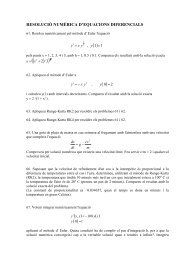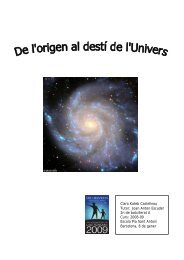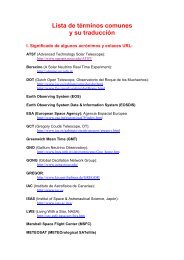Universitat de - Departament d'Astronomia i Meteorologia ...
Universitat de - Departament d'Astronomia i Meteorologia ...
Universitat de - Departament d'Astronomia i Meteorologia ...
You also want an ePaper? Increase the reach of your titles
YUMPU automatically turns print PDFs into web optimized ePapers that Google loves.
5.5. Conclusions 145<br />
measurement at 20 cm wavelength could be compatible with a non-thermal optically<br />
thin spectrum. However, simultaneous observations during July 30 show a flattening<br />
of the spectrum at higher wavelengths, which could be due to self-absorption in this<br />
energy range. The difference between the NVSS and our flux <strong>de</strong>nsity measurement<br />
at 20 cm wavelength could be due to intrinsic variability and/or to the different<br />
VLA configurations used. Anyway, non-thermal synchrotron radiation remains as<br />
the most plausible interpretation for the radio emission of this source, specially at<br />
higher frequencies. The optical counterpart appears as a point-like object with the<br />
magnitu<strong>de</strong>s of an absorbed object at low galactic latitu<strong>de</strong>s. These properties are in<br />
good agreement with the expected ones for a microquasar, although the one-si<strong>de</strong>d<br />
radio jet at arcsecond scales is most common in extragalactic objects.<br />
1RXS J072418.3−071508. This source has been recently (March 2002) classi-<br />
fied as a quasar in the SIMBAD database, and it is not any more a REXB can-<br />
didate. It is listed as PMN J0724−0715 in the NED database, and is the source<br />
WGA J0724.3−0715 in Perlman et al. (1998), who reported a faint and quite broad<br />
Hα emission line (rest-frame Wλ = 30.3 ˚A, FWHM=4000 km s −1 ), and classified it<br />
as a flat spectrum radio quasar with z = 0.270. Nevertheless, we have reported here<br />
our observational results for this source, since it was a candidate when we performed<br />
the observations. In the radio it displays a low <strong>de</strong>gree of variability of 3% at 3.6 cm<br />
and 4% at 6 cm, with a flat or even inverted spectrum. In the optical it appears as<br />
a complex double object, with a NW and a SE components, being the first one the<br />
counterpart to the radio source. Magnitu<strong>de</strong>s in V , R and I typical of absorbed objects<br />
at low galactic latitu<strong>de</strong>s were found. On the other hand, it appears catalogued<br />
with an X-ray extension of 40 ′′ in the RBSC.<br />
5.5 Conclusions<br />
After the cross-i<strong>de</strong>ntification of catalogs presented in Chapt. 4, we found 8 interesting<br />
sources to be studied (Group 1 sources). Here we have reported observations<br />
of all these sources except 1RXS J181119.4−275939 and 1RXS J185002.8−075833,<br />
that were not visible during our observations. We have studied the remaining 6<br />
radio sources of Group 1, and found optical counterparts to all of them. We have<br />
obtained accurate positions at both radio and optical wavelengths, perfectly com-






